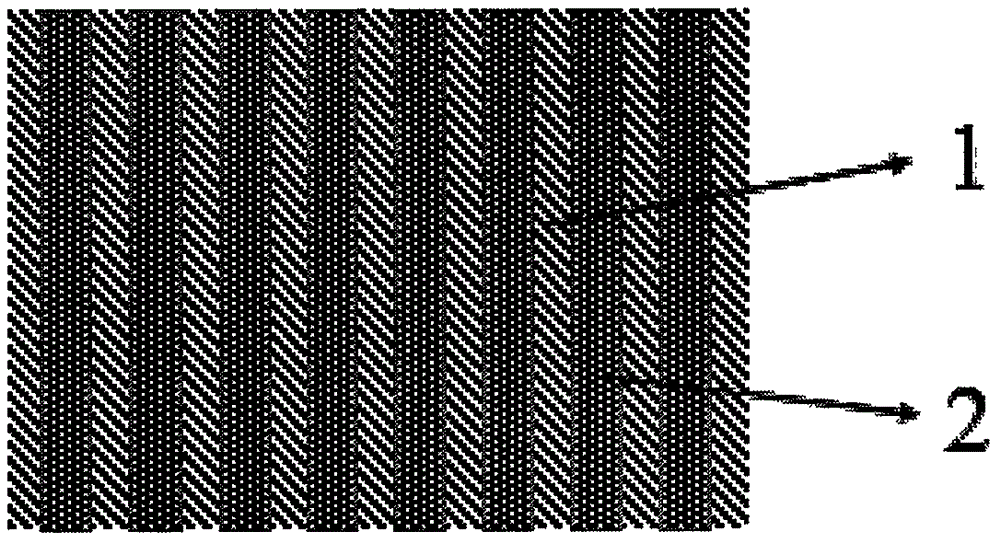Composite thermal interface material of orientated pored graphene foam and low-melting-point alloy
A technology of graphene foam and thermal interface materials, applied in the field of thermally conductive materials, can solve problems such as long thermal conduction paths, unfavorable thermal conductivity, and large thermal resistance
- Summary
- Abstract
- Description
- Claims
- Application Information
AI Technical Summary
Problems solved by technology
Method used
Image
Examples
example 1
[0010] The composite thermal interface material provided in this embodiment is composed of a graphene foam with directional pores and a low melting point alloy, and the low melting point alloy is uniformly filled in the pores of the graphene foam. The directional holes of the graphene foam are parallel to the heat transfer direction, and the pore size is 1300 microns. The low melting point alloy is an indium-bismuth-tin-gallium alloy with a mass ratio of In100Bi66Sn33Ga1.2 and a melting point of 63°C. The thermal conductivity of the above composite thermal interface material was tested on the Longwin TIM LW-9389 steady state heat flow thermal conductivity tester (Taiwan Ruiling Technology Co., Ltd.). When the test temperature is 30℃, the thermal conductivity is 8W / (m·k) ); When the test temperature is 70℃, the thermal conductivity is 36W / (m·k).
example 2
[0012] The composite thermal interface material provided in this embodiment is composed of a graphene foam with directional pores and a low melting point alloy, and the low melting point alloy is uniformly filled in the pores of the graphene foam. The directional holes of the graphene foam are parallel to the heat transfer direction, and the pore size is 1300 microns. The low melting point alloy is an indium-bismuth-tin-gallium alloy with a mass ratio of In100Bi62Sn31Ga16 and a melting point of 47°C. The thermal conductivity of the composite thermal interface material was tested on the Longwin TIM LW-9389 steady-state heat flow thermal conductivity tester (Taiwan Ruiling Technology Co., Ltd.). When the test temperature is 30℃, the thermal conductivity is 13W / (m·k) ); When the test temperature is 60℃, the thermal conductivity is 42W / (m·k).
example 3
[0014] The composite thermal interface material provided in this embodiment is composed of a graphene foam with directional pores and a low melting point alloy, and the low melting point alloy is uniformly filled in the pores of the graphene foam. The directional holes of the graphene foam are parallel to the heat transfer direction, and the pore size is 700 microns. The low melting point alloy is an indium-bismuth-tin-gallium alloy with a mass ratio of In100Bi66Sn33Ga1.2 and a melting point of 63°C. The thermal conductivity of the above composite thermal interface material was tested on the Longwin TIM LW-9389 steady-state heat flow thermal conductivity tester (Taiwan Ruiling Technology Co., Ltd.). When the test temperature is 30℃, the thermal conductivity is 5W / (m·k) ); When the test temperature is 70℃, the thermal conductivity is 32W / (m·k).
PUM
| Property | Measurement | Unit |
|---|---|---|
| Thermal conductivity | aaaaa | aaaaa |
| Aperture | aaaaa | aaaaa |
| Thermal conductivity | aaaaa | aaaaa |
Abstract
Description
Claims
Application Information
 Login to View More
Login to View More - R&D
- Intellectual Property
- Life Sciences
- Materials
- Tech Scout
- Unparalleled Data Quality
- Higher Quality Content
- 60% Fewer Hallucinations
Browse by: Latest US Patents, China's latest patents, Technical Efficacy Thesaurus, Application Domain, Technology Topic, Popular Technical Reports.
© 2025 PatSnap. All rights reserved.Legal|Privacy policy|Modern Slavery Act Transparency Statement|Sitemap|About US| Contact US: help@patsnap.com

